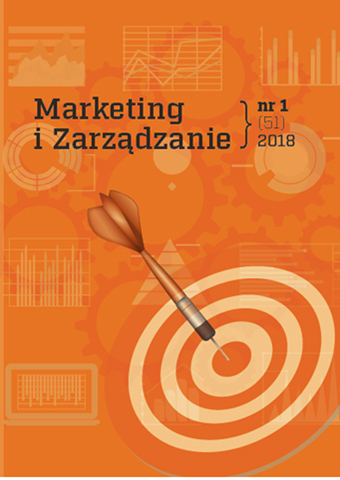
ISSN: 2450-775X
OAI
DOI: 10.18276/miz.2018.51-12


Issue archive /
nr 1 (51) 2018
Zarządzanie karierą z perspektywy jednostki i organizacji
(Career Management from an Indyvidual’s and Organization’s Perspective)
| Authors: |
Agnieszka
Jarosik-Michalak
Wyższa Szkoła Zarządzania w Gdańsku, Wydział Informatyki i Zarządzania |
| Keywords: | career management individual career management career management model |
| Data publikacji całości: | 2018 |
| Page range: | 8 (123-130) |
| Klasyfikacja JEL: | M12 |
Abstract
The aim of the article is to indicate and discuss the actions to be taken by an individual and organization as part of career management. The author presents two approaches that show the next steps in managing a career. Provides tips that help achieve the goals of both the individual and the organization, because career management requires an initiative on both sides. In exchange for the employees’ involvement in achieving strategic goals of the organization must offer them broad opportunities for professional development at all levels of the organizational hierarchy. The matching process is a key factor in determining success.
Download file
Article file
Bibliography
| 1. | Adamczyk, A., Jarecki, W. (2008). Szacowanie wewnętrznej stopy zwrotu inwestycji w wyższe wykształcenie. Gospodarka Narodowa, 11–12, 77–93. |
| 2. | Baruch, Y. (2006). Career development in organizations and beyond: Balancing traditional and contemporary viewpoint. Human Resource Management, 16 (2), 125–138. DOI: 10.1016/j.hrmr.2006.03.002. |
| 3. | Becker, G.S. (1964). Human capital: A theoretical and empirical analysis with special reference to education. New York: Oxford Press. |
| 4. | Greenhaus, J.G., Callanan, G.A., Godshalk, V.M. (2000). Career management. Mason: South-Western. |
| 5. | Greenhaus, J.H., Powell, G.N. (2012). The family-relatedness work decisions: A framework and agenda for theory and research. Journal of Vocational Behavior, 80 (2), 246–255. DOI: 10.1016/j.jvb.2011.12.007. |
| 6. | Herriot, P. (1992). The career management challenge: Balancing individual and organizational needs. London: Sage. |
| 7. | Hirsch, P.M., Shanley, M. (1996). The rhetoric of boundaryless or how the newly empowered managerial class bought into its own marginalization. W: M.B. Arthur, D.M. Rousseau (red.), The Boundaryless career: A new employment principle for a new organizational era (s. 218–233). New York: Oxford University Press. |
| 8. | Jarecki, W. (2004). Weryfikacja kompetencji kandydatów poprzez próbny okres pracy. Zarządzanie Zasobami Ludzkimi, 1, 92–99. |
| 9. | Jarecki, W. (2016). Wartości wyznawane przez osoby wchodzące na rynek pracy. Marketing i Rynek, 3, 263–271. |
| 10. | Jiang, Z., Hu, X., Wang, Z. (2018). Career adaptability and plateaus: The moderating effects of tenure and job self-efficacy. Journal of Vocational Behavior, 104, 59–71. DOI: 10.1016/j.jvb.2017.10.006. |
| 11. | King, Z. (2004). Career management – A CIPD guide. London: CIPD. |
| 12. | Kossek, E.E., Roberts, K., Fisher, S., Demarr, D. (1998). Career self-management: A quasi-experimental assessment of the effects of a training intervention. Personnel Psychology, 51, 935–962. |
| 13. | Muchinsky, D.M., Monahan, C.J. (1987). What is person–environment congruence? Supplementary versus complementary models of fit. Journal of Vocational Behavior, 31 (3), 268–277. DOI: 10.1016/0001-8791(87)90043-1. |
| 14. | Noe, R.A., Noe, A.W., Buchhuber, J.A. (1990). An investigation of the correlates of career motivation. Journal of Vocational Behavior, 37 (3), 340–356. DOI: 10.1016/0001-8791(90)90049-8. |
| 15. | Noe, R.A., Steffy, B. (1987). The influence of individual characteristics and assessment center evaluation on career exploration behavior and job involvement. Journal of Vocational Behavior, 30 (2), 187–202. DOI: 10.1016/0001-8791(87)90018-2. |
| 16. | Pazy, A. (1988). The relationship between organizational and individual career management and the effectiveness of careers. Group and Organizational Studies, 13 (3), 311–331. DOI: 10.1177/105960118801300305. |
| 17. | Pocztowski, A. (2008). Zarządzanie zasobami ludzkimi. Strategie – procesy – metody. Warszawa: PWE. |
| 18. | Rodrigues, R., Guest, D., Oliveira, T., Alfes, K. (2015). Who benefits from independent careers? Employees, organizations, or both? Journal of Vocational Behavior, 91, 23–34. DOI: 10.1016/j.jvb.2015.09.005. |
| 19. | Schein, E.H. (1976). Increasing organizational effectiveness through better human resources planning and development. Sloan School of Management, 1 (1), 1–11. |
| 20. | Schein, E.H. (1978). Career dynamics: Matching individual and organizational needs. Reading: Addison-Wesley. |
| 21. | Schein, E.H., Van Maanen, J. (2016). Career anchors and job/role planning: Tools for career and talent management. Organizational Dynamics, 45, 165–173. DOI: 10.1016/j.orgdyn.2016.07.002. |
| 22. | Stevens, N.D. (1973). Job-seeking behavior: A segment of vocational development. Journal of Vocational Behavior, 3 (2), 209–219. DOI: 10.1016/0001-8791(73)90011-0. |
| 23. | Sturges, J., Guest, D., Conway, N., Davey, K.M. (2002). A longitudinal study of the relationship between career management and organizational commitment among graduates in the first ten years at work. Journal of Organizational Behavior, 23 (6), 731–748. DOI: 10.1002/job.164. |
| 24. | Sullivan, S.E., Carden, W.A., Martin, D.F. (1998). Careers in the next millennium: |
| 25. | Directions for future research. Human Resource Management Review, 8 (2), 165–185. |
| 26. | Verbruggen, M., Sels, L., Forrier, A. (2007). Unraveling the relationship between organizational career management and need for external career counseling. Journal of Vocational Behavior, 71 (1), 69–83. DOI: 10.1016/j.jvb.2007.03.003. |
| 27. | Weng, Q., McElroy, J.C., Morrow, P.C., Liu, R. (2010). The relationship between career growth and organizational commitment. Journal of Vocational Behavior, 77 (3), 391–400. DOI: 10.1016/j.jvb.2010.05.003. |